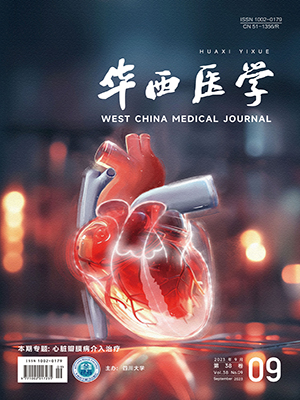【摘要】 目的 觀察帕瑞昔布鈉超前鎮痛在小兒上肢骨折手術的鎮痛效果及不良反應發生情況。 方法 選擇2009年6月-2010年12月氣管插管全身麻醉下擇期行單側上肢骨折切開復位內固定手術患兒90例,隨機分為帕瑞昔布鈉組(P組)、曲馬多組(T組)及對照組(C組),每組各30例患兒;于麻醉前分別靜脈注射帕瑞昔布鈉1 mg/kg、曲馬多2 mg/kg、等容量生理鹽水。3組患兒年齡、性別、體重、手術時間等一般情況差異無統計學意義(P gt;0.05)。各組均于術后2、4、6、8 h各時間點觀察患兒疼痛評分、鎮靜評分;觀察拔除患兒氣管導管后5 min躁動評分;記錄患兒術中芬太尼總用量及術后鎮痛藥物用量;隨訪術后24 h內不良反應的發生情況。 結果 術后各個時間點P組疼痛評分明顯低于T、C組(P lt;0.01);T組鎮靜評分于術后2、4、6 h明顯高于P、C組(P lt;0.01),鎮靜評分在P、C組之間比較差異無統計學意義(P gt;0.05);P組術后躁動評分明顯低于T、C組(P lt;0.01);P組患兒圍手術期芬太尼用量明顯少于T、C組(P lt;0.01);T組術后惡心嘔吐發生率明顯高于P、C組(P lt;0.05)。P組無呼吸抑制、傷口異常出血等嚴重不良反應。 結論 帕瑞昔布鈉超前鎮痛用于小兒上肢骨折手術可產生明顯鎮痛作用,并可有效預防蘇醒期躁動發生,明顯減少圍手術期芬太尼用量,惡心嘔吐等不良反應發生率明顯低于曲馬多。
【Abstract】 Objective To study the efficacy and safety of preemptive analgesia with parecoxib sodium in children undergoing upper limb orthopedic surgery. Methods Ninety children from June 2009 to December 2010 scheduled for elective upper limb orthopedic surgery under general anesthesia were selected and randomly divided into three groups with 30 children in each. For the children in group P (parecoxib sodium), group T (tramadol) and group C (control), preemptive analgesia was induced by an intravenous injection of parecoxib sodium at 1 mg/kg, tramadol at 2 mg/kg, and normal saline respectively before anesthesia. Pain intensity score and sedation score were recorded 2, 4, 6, and 8 hours respectively after operation. The agitation score was measured 5 minutes after extubation. The perioperative fentanyl consumption and postoperative analgesic medicine consumption were recorded. The adverse effects were observed within 24 hours after operation. Results The demographic data such as age, gender, weight, and operation time did not differ statistically among the three groups of children (P gt;0.05). Compared with groups T and C, the pain score in group P was significantly lower at all time points after operation (P lt;0.01). The sedation score in group T was significantly higher than those in group P and C 2, 4, and 6 hours after operation (P lt;0.01), but the sedation score did not differ significantly between groups P and C (P gt;0.05). The agitation score after trachea extubation in group P was significantly lower than the other two groups (P lt;0.01). The quantity of fentanyl used in group P was significantly lower than in groups T and C (P lt;0.01). The incidence of postoperative nausea or vomiting in group T was higher than those in groups P and C (P lt;0.05). There was no depression of breath or abnormal hemorrhage in group P. Conclusion Parecoxib sodium has a better analgesic effect in children undergoing upper limb orthopedic surgery. The agitation score and the incidence of postoperative nausea or vomiting are significantly lower, and the use of parecoxib sodium can also significantly reduce the perioperative fentanyl consumption.
引用本文: 李秀澤,李衛,夏氫. 帕瑞昔布鈉超前鎮痛在小兒上肢骨折手術中的臨床研究. 華西醫學, 2011, 26(8): 1189-1191. doi: 復制




